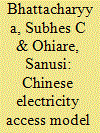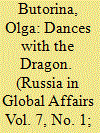|
|
|
Sort Order |
|
|
|
Items / Page
|
|
|
|
|
|
|
| Srl | Item |
| 1 |
ID:
115695


|
|
|
|
|
| Publication |
2012.
|
| Summary/Abstract |
The economic and infrastructural disparities between the rural and urban communities of most developing countries in general and in terms of energy access in particular are quite glaring. China presents a good example of a developing country that has successfully embarked on rural electrification projects over the last few decades and achieved a great feat of almost 100% electrification rate (IEA, 2009. World Energy Outlook, 2009, International Energy Agency, Paris (see IEA website at http://www.worldenergyoutlook.org/electricity.asp.)). The purpose of this paper is to find out how China has achieved this feat; how China's rural energy projects were financed and whether China provides lessons for other countries to follow.
The above questions are examined through an extensive literature review and the paper finds that unlike many other countries following the top-down approach to rural electrification, China has preferred to use a phased development through a bottom-up approach where local resources, and village level development and empowerment played an important role. While the state provided the overall guidance and financial support, the integrated rural development approach has produced local-level solutions that are subsequently integrated to produce an alternative development pathway. Strong government commitment, active local participation, technological flexibility and diversity, strong emphasis on rural development through agricultural and industrial activities and an emphasis on capacity building and training have also played an important role in the success. However, despite achieving the universal access objective, China still faces a number of issues related to rural electricity use, especially in terms of regional use patterns, long-term sustainability of supply and commercial operation of the systems. The Chinese model could serve as an inspiration for other developing countries trying to ensure universal electricity access.
|
|
|
|
|
|
|
|
|
|
|
|
|
|
|
|
| 2 |
ID:
087864


|
|
|
|
|
| Publication |
2009.
|
| Summary/Abstract |
The current crisis is often seen as a match to the Great Depression of the 1930s. Yet there is a hope that it would not evolve into a humanitarian disaster. The standard of living in the crisis-hit countries is much higher now than 80 years ago, and they are not facing the threat of all-out unemployment or poverty. The world's GDP is not going to fall by one quarter within the next few years, and hungry people will not be marching to Washington or other capitals, while inhuman dance marathons, such as the one in Sydney Pollack's movie is likely to forever remain a screenplay.
The two crises are similar in that they both began in the United States, with financial upheavals quickly engulfing the manufacturing sector and a majority of regions of the world. The key common characteristic is the breakdown of market mechanisms. In the 1930s, it was caused by the first wave of globalization. Production technologies changed dramatically at the turn of the 20th century: there was a breakthrough in the development of transport and communications, and transnational oil companies were established and gained a firm footing. As a result, certain national and colonial economies were drawn into the world economic system. The collapse of the New York Stock Exchange on October 24, 1929 put an end to an erratic market. It turned out that market forces could not run the world economy without an active participation by the state.
|
|
|
|
|
|
|
|
|
|
|
|
|
|
|
|
| 3 |
ID:
120229


|
|
|
|
|
| Publication |
2013.
|
| Summary/Abstract |
In studying the policy responses to economic crises in ASEAN and the EU, this paper addresses three issues: the financial crisis of 1997-98 in Southeast Asia, and the European Union's financial crisis of 2008 followed by the sovereign debt crisis; policy adjustment actions in both regions in the area of economic coordination; and areas of mutual policy inspiration for both regions.
Both crises studied were regionally risk-intensive. However, their natures were different. The Asian crisis was mainly externally driven by capital flows, while the EU one - especially the sovereign debt part of it - was predominantly of an internal nature due to imbalances in the euro area and a worsening of the situation in public finances in some euro members. On top of it, the pre-crisis economic governance structure differed with a light one in ASEAN and a deeper one in the EU; however, economic policy was still based dominantly on coordination.
The policy adjustment corresponds to the nature of the crisis and original governance structures. In ASEAN, it is characterized somewhat both by a deepening of regional cooperation and a widening of risk-pooling beyond the borders of the region (ASEAN Plus). On the EU side, the policy response privileges a strong deepening of policy cooperation coupled with more narrow-looking geographical coverage.
The crises offer a unique window for policy adjustment. ASEAN could consider: deepening multi-lateralization in the single market; a gradual and low-intensity monetary cooperation; and enhancing its institutional capacity. The EU can, on its side, fully implement its new rules and put them under the EU-27 roof. It can go beyond this and consider a broader economic partnership with some of the new instruments with the EFTA countries. Finally, it can also reflect on the ASEAN success with the enlargement of its regional influence - how to strengthen its leadership in its closest neighbourhood (Balkans, North Africa, Eastern Partnership) by ensuring an area of stability and prosperity.
|
|
|
|
|
|
|
|
|
|
|
|
|
|
|
|
| 4 |
ID:
146980


|
|
|
|
|
| Summary/Abstract |
This article explores the “fundamentalist dilemma,” or how fundamentalist movements participate in secular political systems, especially when they gain prominent political positions that allow them to impose their extreme ideology on the entire society. After analyzing prevailing responses to this dilemma, ranging from political integration to aggressive takeover, the article turns to the case of Israeli Haredim. It explores three models of political integration through which Haredim have applied religious practices in the public sphere: protest, consolidation, and takeover. The study's main finding is that, opposite to a commonly accepted assumption that fundamentalists’ integration into secular politics causes them to moderate, the more political power that fundamentalists accrue the stronger is their tendency to promote their religious agenda. Yet the Israeli Haredi case also reveals the limitations of this tendency: fundamentalists often restrain their expansionist instinct when having to take nonfundamentalist reactions into consideration.
|
|
|
|
|
|
|
|
|
|
|
|
|
|
|
|
| 5 |
ID:
170579


|
|
|
|
|
| Summary/Abstract |
he immediate challenge is to consolidate progress already made and grab the low-hanging fruit
|
|
|
|
|
|
|
|
|
|
|
|
|
|
|
|
| 6 |
ID:
149222


|
|
|
|
|
| Summary/Abstract |
As the government announces a programme to teach Muslim women to speak English, this article examines how such a policy can be implemented successfully, arguing that lessons can be drawn from both academic research, especially that carried out with Muslim women themselves, and previous successful policy application. It focuses on two projects carried out in the recent past for the Learning and Skills Council (LSC) and Jobcentre Plus, and outlines the key factors that led to their success. The LSC project involved one of the largest in-depth surveys of Muslim women's attitudes towards work, and their views on life in Britain, that has ever been undertaken. The Jobcentre Plus project was a highly successful and innovative employment training initiative for ethnic minority women piloted in Sheffield, the very kind of ‘targeted’ approach that Mr Cameron has claimed his government's new language initiative will be.
|
|
|
|
|
|
|
|
|
|
|
|
|
|
|
|
|
|
|
|
|